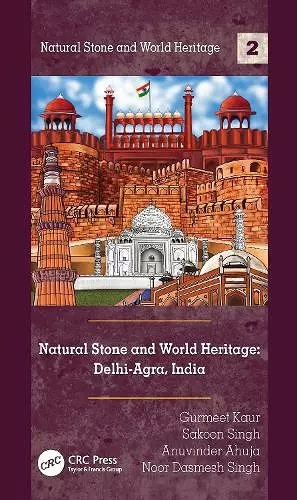Natural Stone and World Heritage: Delhi-Agra, India
Gurmeet Kaur author Sakoon Singh author Anuvinder Ahuja author Noor Singh author
Format:Hardback
Publisher:Taylor & Francis Ltd
Published:27th May '20
Currently unavailable, and unfortunately no date known when it will be back
This hardback is available in another edition too:
- Paperback£49.99(9781032570808)

This book discusses heritage stones which were used in the making of the architectonic heritage of Delhi and Agra, encompassing UNESCO world heritage sites and heritage sites designated as prominent by the Indian government. The most famous monument of the two cities is the ‘Taj Mahal’ of Agra.
The book focuses on the geological characteristics of the famous Makrana marble, red sandstone and other sandstone variants of the Vindhyan basin and Delhi quartzite, the most widely used stones in almost all the monuments, as well as on their quarries. The work also aims to sensitise the public to protecting and preserving the architectonic heritage of these two densely populated cities in India as repositories of our past cultures and traditions. Identifying the nature and provenance of stones/rocks used in construction will lead to better restoration for future generations, in light of the deterioration of architectonic heritage through various natural weathering agencies and anthropogenic activities.
The book will serve as a useful source book to economic geologists, geologists, archaeologists, architects, historians and stone industry operators specifically and to academic and non-academic communities, travellers and tourism industry operators in general. The book will benefit students, researchers, and rock enthusiasts spanning all age groups and academic levels.
This book provides a useful description of several World Heritage buildings in northern India, such as The Taj Mahal and the Delhi Red Fort, with particular reference to the geological character of the materials used in their construction together with summaries of the origins of the buildings in their historical context. Although the book covers a very wide range of topics which cannot be considered in detail the authors provide many links to the diverse source material they have utilized. The emphasis of the work is on the Makrana marbles and the Vindhyan X sandstones; both now designated as World Heritage Building Stones. Descriptions are provided of the geology of their source regions and the petrography of the rocks. The book is well illustrated with respect to geological and historical maps, the quarries from which the building stones were extracted, and excellent illustrations of the heritage buildings. The geological parts of the book are not overly technical and can be readily understood by anyone with a smattering of geological knowledge. The work also includes recommendations for preservation of both the stone quarries and the monuments. The book is important in that it brings together in one volume material which will appeal not only to geoscientists, geohistorians and architectural historians but to any one visiting these well know cultural sites. In this regard the regard the work is more useful than many existing travel guides.
Roger Mitchell, Professor Emeritus, Lakehead University, Thunder Bay, Ontario, Canada
The book Natural Stone and World Heritage: Delhi-Agra, India is a delightful trip to these important Unesco World Heritage Sites. All the monuments of Delhi and Agra are very well described in this richly illustrated publication. It is interesting to learn about the different stones used in their buildings, namely Makrana Marble, Vindhyan Sandstone and Delhi Quartzite, as well as knowing more about historical quarries. You will discover the countless precious stones inlaid in the Makrana Marble of Taj Mahal, Agra Fort, Red Fort and Humayun’s Tomb. The authors also discuss the conservation of these sites. It is a book that unites culture, geology and history.
Eliane Del Lama, Associate Professor, Institute of Geosciences, University of São Paulo, Brazil
This book provides a useful description of several World Heritage buildings in northern India, such as The Taj Mahal and the Delhi Red Fort, with particular reference to the geological character of the materials used in their construction together with summaries of the origins of the buildings in their historical context. Although the book covers a very wide range of topics which cannot be considered in detail the authors provide many links to the diverse source material they have utilized. The emphasis of the work is on the Makrana marbles and the Vindhyan X sandstones; both now designated as World Heritage Building Stones. Descriptions are provided of the geology of their source regions and the petrography of the rocks. The book is well illustrated with respect to geological and historical maps, the quarries from which the building stones were extracted, and excellent illustrations of the heritage buildings. The geological parts of the book are not overly technical and can be readily understood by anyone with a smattering of geological knowledge. The work also includes recommendations for preservation of both the stone quarries and the monuments. The book is important in that it brings together in one volume material which will appeal not only to geoscientists, geohistorians and architectural historians but to any one visiting these well know cultural sites. In this regard the regard the work is more useful than many existing travel guides.
Roger Mitchell, Professor Emeritus, Lakehead University, Thunder Bay, Ontario, Canada
The book Natural Stone and World Heritage: Delhi-Agra, India is a delightful trip to these important Unesco World Heritage Sites. All the monuments of Delhi and Agra are very well described in this richly illustrated publication. It is interesting to learn about the different stones used in their buildings, namely Makrana Marble, Vindhyan Sandstone and Delhi Quartzite, as well as knowing more about historical quarries. You will discover the countless precious stones inlaid in the Makrana Marble of Taj Mahal, Agra Fort, Red Fort and Humayun’s Tomb. The authors also discuss the conservation of these sites. It is a book that unites culture, geology and history.
Eliane Del Lama, Associate Professor, Institute of Geosciences, University of São Paulo, Brazil
ISBN: 9780367251802
Dimensions: unknown
Weight: 408g
186 pages